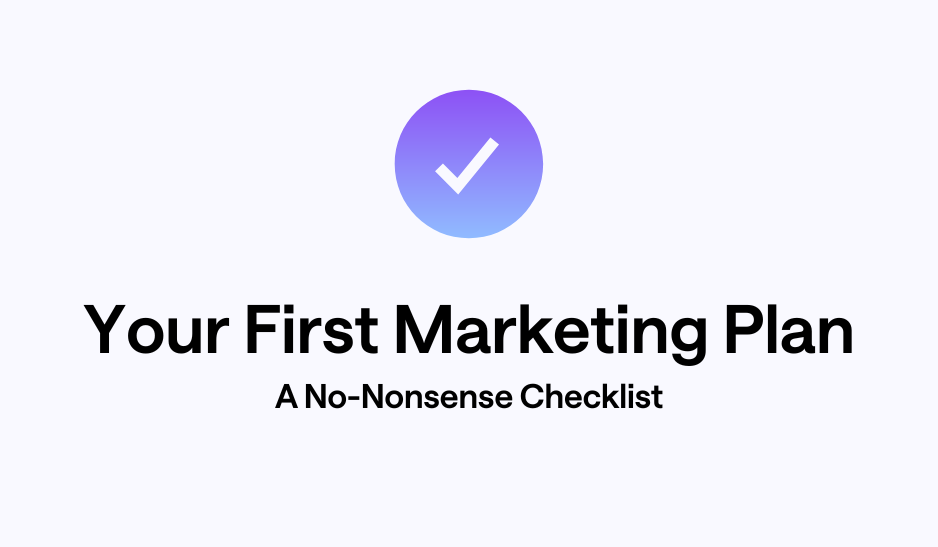Cambium AI vs. Traditional Agencies: Which Is Better for For GTM?
In today's hyper-competitive market, speed is not just an advantage; it's a prerequisite for survival. For senior leaders, the pressure to launch new products, enter new markets, and capture mindshare has never been greater. The critical first step is always the same: a robust go-to-market (GTM) strategy. This plan is the blueprint for how you’ll engage with customers to gain a competitive advantage.
Traditionally, crafting this blueprint has been the domain of marketing and strategy agencies. These firms offer deep expertise, but their process is often resource-intensive, slow, and expensive. Now, a new contender has emerged: AI-powered strategy platforms like Cambium AI.
This shift presents a pivotal choice for leaders: Do you stick with the established agency model or leverage AI to accelerate your path to market? This isn't just a question of old vs. new. It's a strategic decision that impacts your budget, timeline, and the very agility of your organization.
Let's break down the comparison across the four factors that matter most to senior leaders: Speed, Cost, Auditability, and Handoff to your internal teams.
1. Speed: From Months to Minutes
The most significant bottleneck in any GTM plan is the time it takes to move from idea to execution. Delays in this phase mean lost revenue, squandered first-mover advantage, and more time for competitors to react.
The Traditional Agency Timeline
When you engage a traditional agency, you are initiating a human-powered, multi-stage process. It typically looks something like this:
-
Discovery & Onboarding (2-4 weeks): A series of meetings, stakeholder interviews, and workshops to understand your business, product, and goals.
-
Market Research (4-6 weeks): The agency team conducts competitor analysis, customer interviews, and industry research to gather raw data.
-
Strategy Formulation (2-4 weeks): Analysts and strategists synthesize the research into key insights, define target personas, size the market, and craft the core narrative.
-
Presentation & Revisions (1-2 weeks): The agency presents its findings in a polished slide deck, followed by feedback rounds and adjustments.
All told, a comprehensive GTM strategy from a traditional agency can easily take two to four months from kickoff to final delivery. For a company operating in a fast-moving sector, this timeline can feel like an eternity.
The Cambium AI Advantage: Instant Strategy
Cambium AI fundamentally collapses this timeline. By leveraging a large language model trained on vast datasets and live web knowledge, the platform automates the entire research and synthesis process.
Here’s how it works: You provide the URL of your website. Within minutes, Cambium AI analyzes your public-facing content to understand your product, value proposition, and intended audience. It then instantly generates a complete GTM strategy, including:
-
Core Brand & Audience Analysis: Brand essence, archetypes, and a preliminary list of competitors.
-
Customer Personas: Detailed personas with estimated demographics and deep psychographic insights into their motivations and pain points.
-
Market Sizing: A top-down analysis of your Total Addressable Market (TAM), Serviceable Addressable Market (SAM), and Serviceable Obtainable Market (SOM).
-
Investor Narrative: Key talking points and content for a pitch deck. (coming soon)
What takes an agency a full quarter, Cambium AI delivers in less time than it takes to drink a cup of coffee. This isn't just an incremental improvement; it's a paradigm shift in strategic planning. It allows your team to move from a blank page to a robust, data-informed starting point in a single session.
Winner: Cambium AI. The difference in speed is measured not in days or weeks, but in orders of magnitude.
.png?width=3200&height=2400&name=In%20Post%20Blog%20Images%20(50).png)
2. Cost: Democratizing Access to High-Level Strategy
For any leader, budget is a primary constraint. Allocating capital effectively is crucial, and GTM strategy often represents a significant upfront investment with no immediate, tangible return.
The Traditional Agency Price Tag
Expertise comes at a premium. Engaging a reputable strategy agency is a major financial commitment. According to a report from HubSpot, marketing agency retainers can range from $2,500 to over $10,000 per month, with project-based fees for a full GTM strategy often starting at $25,000 and easily exceeding $75,000 depending on the scope.
For startups and even mid-sized companies, this cost can be prohibitive. It forces a difficult trade-off: Do you invest in strategy, or do you allocate that budget to product development or hiring? Too often, robust strategic planning is sidelined in favor of more immediate operational needs.
The Cambium AI Model: High ROI, Low Overhead
Cambium AI operates on a SaaS model, making strategic planning accessible and affordable. Instead of a massive, one-time project fee, you get access to a powerful strategic tool for a predictable, low monthly cost.
This model fundamentally changes the economic equation.
-
Reduced Upfront Investment: You eliminate the five- or six-figure check required to even begin a project with an agency.
-
Iterate Without Penalty: Want to explore a new product angle or target a different market segment? With an agency, a pivot means a new scope of work and a new invoice. With Cambium AI, you can run a new analysis instantly at no extra cost.
-
Empower Internal Teams: The low cost allows you to equip your entire marketing, product, and leadership team with a powerful tool, fostering a culture of strategic thinking across the organization.
By drastically lowering the financial barrier, Cambium AI democratizes the go-to-market strategy. It’s no longer a luxury reserved for the best-funded companies but a foundational tool available to anyone.
Winner: Cambium AI. The cost differential is substantial, providing an exponentially higher ROI and allowing for greater strategic flexibility.
3. Auditability: Opening the "Black Box"
When you receive a 100-page slide deck from an agency, how do you truly validate its conclusions? You trust the agency's process, but the raw data, the reasoning behind persona development, and the specific inputs for market sizing can often feel like a "black box." You see the polished output, but not the machinery that produced it.
The Agency's Opaque Process
While good agencies will share their sources, the synthesis is inherently subjective. It’s shaped by the individual experiences and biases of the consultants on the project. If a key strategist leaves the agency mid-project, you can lose critical context. Questioning a specific assumption can lead to defensive conversations and additional billable hours to "dig up the data."
Cambium AI's Transparent Foundation
Cambium AI offers a different kind of auditability. The core input is clear and transparent: your website's URL. The platform's analysis is based on the public content you’ve already created, combined with the LLM's vast, real-time knowledge of the broader market.
This creates a clear, auditable trail:
-
The "Why" is Traceable: If Cambium AI identifies a specific customer pain point, it’s because it found language on your site hinting at that solution. If it suggests a competitor, it’s based on an analysis of your market positioning.
-
You Control the Input: Don't agree with the output? Refine the copy on your website. Clarify your value proposition, and run the analysis again. This gives you direct control over the strategic foundation. The strategy evolves with your own messaging.
-
Consistency: The platform provides a consistent, unbiased analysis every time.
This doesn't mean the AI is infallible, but it does mean the starting point is objective and directly tied to your own stated brand identity. The strategy becomes a direct reflection of how you present yourself to the world, making it easier for your internal team to vet, validate, and build upon.
Winner: Cambium AI. It replaces subjective human synthesis with a transparent, repeatable process that you can directly influence.
.png?width=3200&height=2400&name=In%20Post%20Blog%20Images%20(52).png)
4. Handoff: Closing the Strategy-to-Execution Gap
A GTM strategy is useless if it sits on a shelf. Its value is only realized when it's effectively handed off to your internal marketing, sales, and product teams for execution. This is often where the process breaks down.
The Agency Handoff Problem
Agencies are masters of the "grand reveal." They present a beautiful deck full of high-level insights: personas, market maps, and strategic pillars. The problem? Your internal team is left to translate those abstract concepts into tangible work.
-
What ad copy best resonates with "Persona A"?
-
What blog topics address the pain points of "Persona B"?
-
How do we turn the "strategic narrative" into a compelling email sequence?
This translation effort, known as the strategy-to-execution gap, creates friction, delays, and a high risk of the original strategic intent being lost. The team that created the strategy (the agency) is not the team that has to live with it every day.
Cambium AI's Actionable Output
Cambium AI is designed to bridge this gap. It excels at moving from high-level concepts to tactical assets. The platform doesn't just give you a persona named "Startup Steve"; it provides suggestions for ad copy, targeting parameters, and content angles specifically designed to engage him.
The output is not just a strategic document; it's a starter kit for execution.
-
Ready-to-Use Content: Your marketing team gets ad copy and narrative points, not just theories.
-
Clear Targeting: Your demand generation team gets specific guidance on who to target.
-
Investor-Ready Narrative: Your leadership team gets the core content for their next pitch deck.
This makes the handoff seamless because there's less to hand off. The strategy and the initial tactical assets are delivered in a single, unified package. Your team can spend less time interpreting and more time implementing, testing, and optimizing.
Winner: Cambium AI. It delivers an actionable GTM toolkit, not just a theoretical framework, dramatically reducing the friction between strategy and execution.
The Final Verdict: Augmentation, Not Just Replacement
| Feature | Traditional Agency | Cambium AI |
| Speed | 2-4 months | Under 5 minutes |
| Cost | $25,000 - $75,000+ | Low monthly SaaS fee |
| Auditability | Opaque, human-led synthesis | Transparent, based on your URL |
| Handoff | High-level, deck creates execution gap | Actionable assets, closes execution gap |
So, is the traditional agency model obsolete? Not necessarily. Agencies still provide immense value in bespoke research, complex qualitative analysis (like in-depth customer interviews), and the high-touch account management that large enterprises require.
However, for the vast majority of companies that need to move fast and deploy capital efficiently, the ground has shifted.
For a senior leader, the choice isn't necessarily a binary one. The most effective approach may be a hybrid:
-
Start with Cambium AI: Generate your foundational GTM strategy in minutes. Use this comprehensive, data-informed document as your baseline.
-
Validate and Refine Internally: Your team now has a rich starting point to debate, test, and build upon. You've skipped months of discovery and gone straight to refinement.
-
Engage Agencies for Specific Tasks: If you still need specialized help, you can now engage an agency for a much more focused (and less expensive) project, such as running a series of focus groups to validate an AI-generated persona or executing a creative campaign based on the AI-generated strategy.
In the modern business landscape, your greatest competitive advantage is your ability to learn and adapt faster than anyone else. By compressing the GTM planning cycle from months to minutes, Cambium AI gives you exactly that. It allows you to test more ideas, enter more markets, and ultimately, execute your vision with the speed and precision the market demands.

.png)
